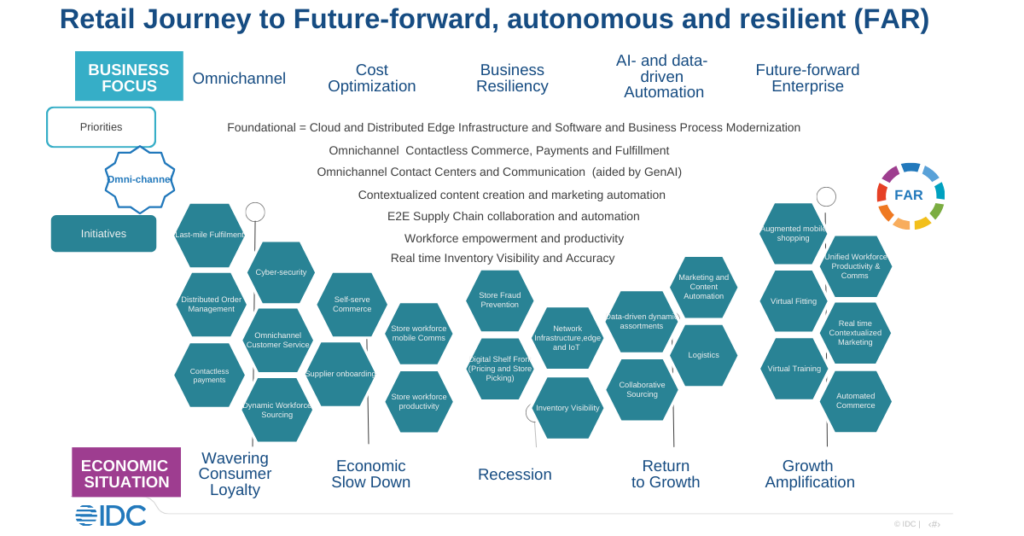The path to enabling omnichannel business has required continual evolution that included adding net new applications and systems, evolving through digital transformation, AI and mobile everywhere, to the current era of Generative AI (GenAI) and intelligent edge computing.
Now the industry is on a journey to becoming future-forward, autonomous, and resilient (FAR), leveraging AI and GenAI to take retail reinvention even farther. Let’s explore how retailers can continue to improve on omnichannel by focusing on the customer, with the most efficient product flows and engaging employee experiences in mind. The path from Omnichannel to FAR is continuous and ongoing as illustrated in the following graphic.

GenAI and Intelligent Edge Computing: Pioneering FAR
The current era of AI-everywhere underpins FAR, and requires an exploration of GenAI’s potential, coupled with investment in intelligent edge computing. Software investments are increasingly directed towards GenAI platforms capable of creating personalized content, designing new products, and enhancing customer service with sophisticated chatbots/virtual assistants.
Hardware investments now focus on high-performance computing systems to support the demanding requirements of GenAI algorithms. Distributed edge platforms, AI PC’s and AI-chips will improve compute response, throughput and efficiency. This will make AI at the edge very possible in stores. Services are evolving to include ethical AI consulting, ensuring that the use of GenAI aligns with privacy and fairness standards.
The supply chain is experiencing a revolution with AI-driven predictive analytics, autonomous systems, and real-time tracking. RFID mandates from a relatively short, but very important list of retailers will drive traceability and improved inventory control in non-food products. The frontline workforce will benefit as the focus on serving customers well is prioritized as routine tasks are automated.
Advice for Continuing to Navigate the Journey to FAR
The reinvention of retail in the AI era is a testament to the industry’s resilience and adaptability. It promises a future where retail experiences are not only more engaging and convenient but also where back-office efficiencies, the supply chain and frontline workforce play a crucial role in delivering value through a blend of technology and human touch.
In an era marked by rapid technological advancements and shifting consumer expectations, retailers face the imperative to evolve. Retailers need to embrace becoming future forward, autonomous and resilient. FAR transformation is not just an ambition but a necessity for thriving in the competitive landscape.
Following are recommendations for retailers aiming to navigate the journey to FAR successfully:
Become Future-Forward by Embracing Technological Innovation
- Invest in AI, Machine Learning, and GenAI – Leverage AI, machine learning (ML), and GenAI to enhance every aspect of your business, from personalized customer experiences to efficient supply chain management. GenAI can revolutionize customer experiences, human resource and finance operations, IT estate management, product design and content creation. Predictive analytics can forecast trends and optimize inventory planning and sourcing. Importantly, workflow and work processes are being revolutionized with the help of GenAI, with near-term ROI possible.
- Adopt Intelligent Edge Computing – Implement intelligent edge computing to process data closer to where it is generated, reducing latency and improving customer experiences. This technology supports real-time decision-making in areas like inventory management, loss prevention, and personalized in-store promotions.
- Explore Traceability Applications – Utilize traceability applications to enhance supply chain transparency and security. This can build trust with consumers by providing verifiable information about product origins, manufacturing processes, and sustainability practices.
Become Autonomous Through Decentralization and Automation
- Empower the Workforce – Empower your frontline employees with the tools and authority to make decisions in real-time, enhancing customer service and operational efficiency. This can be supported by AI-driven insights and mobile technologies. Empower the back-office and mid-office with tools that speed decision processes in planning, human resources, finance, and operations. Robotic process automation (RPA) can eliminate unnecessary steps in business processes.
- Implement Autonomous Systems – Deploy autonomous systems, such as automated warehouse and distribution capabilities, and autonomous delivery vehicles and drones, to streamline operations and reduce reliance on manual processes. This not only improves efficiency but also allows your workforce to focus on higher-value tasks.
Become Resilient
- Diversify Supply Chains – Build resilience by diversifying your supply chain, reducing dependency on single sources, and exploring local or regional suppliers. This can mitigate risks related to geopolitical tensions, natural disasters, and global pandemics.
- Develop a Robust Digital Infrastructure – Ensure your digital infrastructure is robust, scalable, and secure. This includes investing in cloud computing, cybersecurity measures, and disaster recovery plans to safeguard against data breaches and ensure business continuity.
- Foster Strong Relationships with Customers and Partners – Build strong relationships with your customers and business partners. Engage with customers through personalized experiences and responsive customer service. Collaborate with partners to innovate and co-create value.
The retail industry’s journey highlights a broader trend towards a FAR transformation. Retailers are leveraging AI to create immersive, efficient, and tailored shopping experiences while ensuring their supply chain and frontline workforce are equipped to thrive in this new landscape. Retail organizational DNA needs to adapt to continuously learning and adapting to consumer needs by leveraging a technological foundation that is inherently smarter and nimbler.
Conclusion
The journey from the dawn of omnichannel to the FAR era reflects a broader trend towards increasingly sophisticated and adaptable, data-driven, automated, and personalized retail experiences. As technology continues to advance, the challenge for retailers will be to balance investment in innovation with the need to deliver tangible value to consumers.
The evolution of retail investments tells the story of an industry in constant flux, striving to meet the ever-changing demands of consumers in an increasingly digital world. As technology continues to advance, the possibilities for retail are endless. The integration of AI into retail operations has transitioned from a competitive advantage to a necessity, with significant impacts to technology investment, business processes, and the workforce.
Becoming future-forward, autonomous, and resilient requires a holistic approach that encompasses technological innovation, cultural transformation, and strategic partnerships. By embracing these principles, retailers can navigate the challenges of the digital era, meet evolving consumer expectations, and secure a competitive edge in the marketplace.
The journey towards this transformation may be complex, but the rewards—sustained growth, operational efficiency, and enhanced customer loyalty—are well worth the effort.
Learn what matters most to your customers with IDC’s AI Use Case Discovery Tool—find out more.




